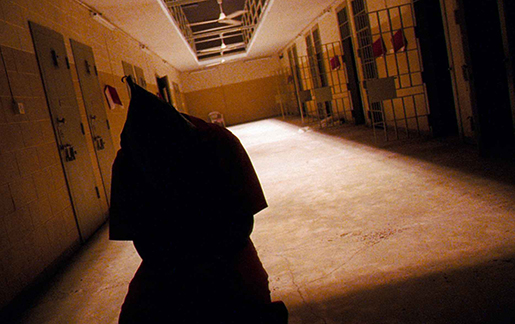Movie Review: STANDARD OPERATING PROCEDURE (2008)

How We Look At It
The price of freedom is tarnishing the moral upstanding of the United States of America. The Bush Administration may not have advertised that so broadly, but that’s what they were selling. Its president outright denied it: “We don’t torture.” They did and the American people bought it unaware what was happening behind the heavy curtain hiding the actions of Abu Ghraib and Guantanamo Bay. Had the American soldiers confined by their government to torture the prisoners for tainted information not taken a few hundred snapshots, we never would have known what was really going on. When the pictures were released around the world, America had to choke it down. Perhaps the photos were a blessing in disguise, everyone must become humbled before evil atrocities in their name.
Standard Operating Procedure follows the best examples of documented journalism from last year from Charles Ferguson’s No End In Sight to Tony Kaye’s Lake of Fire. The film has also won the Golden Bear at the Berlin Film Festival. Detective-Director Errol Morris (Gates of Heaven, 1978 and Mr. Death: The Rise and Fall of Fred A. Leutcher Jr., 1999) examines the shocking exposé of the Abu Ghraib torture-photography scandal with a dogged determination to simply analyze and discover the limited truth of the photos themselves. It also works as an apology from Morris, an American citizen. By taking the photographs, former MP Ken Davis figures that “(the soldiers) weren’t trying to hide anything.” G.I. Javal Davis reasons that “if you consider yourself dead, you can do all the shit you have to.” Upon the release of the photos to the American public, the government, its military and the people felt worse about this exposure than the actual crimes themselves. The soldiers were to blame while their superiors back home strolled back into the shadows.
The interviewed subjects, photographed harmoniously by Robert Chappell, are young American soldiers, underlings dominated by a handful of superiors in the Army division. The most photographs taken (as well as staged) were by Sergeant Charles Graner who was not allowed to participate in the interviews while being serving his sentence. Described, sometimes in awe, by others in his unit, Graner, seen in odd photos and video clips, comes across as a depraved and vile bully. So manipulative was Graner that he directed his impregnated girlfriend G.I. Lynndie England, who in interviews is surprisingly articulate and even empathetic, to pose with the abused imprisoned men in photos that sealed her infamy. Lynndie’s situation reminds me of an episode from Morris’ criminally short-lived First Person series (2000) about Sondra London, a woman deeply in love with a serial killer. Despite the NO PHOTOGRAPHY signs, the presence of cameras instigated the acts of human degradation: why leash a man if it wasn’t a photo opportunity?
STANDARD OPERATING PROCEDURE Clip: “Gilligan”
Many of the grotesque scenarios such as the human pyramid, the leashed man, and Gilligan (nicknamed by Graner) standing on the box with electric wire attached to his fingers came to be are testified, debunked and measured by evidence. Specialist Sabrina Harmen, one of the photographers, explains that the wires connected to Gilligan were not connected to electricity. Gilligan was told otherwise as a psychological means of depriving the man sleep. The motive for Sabrina’s picture-taking is explained away as the gathering of damning proof: “No one would believe the shit that goes on here”. Sabrina, at one point, contradicts herself when she recalled, “(getting) to laugh and throw corn at (the prisoners). We (didn’t) hit them, that’s a plus.”
These kids fresh out of high school were ordered by decorated superiors to follow remorseless commands that included, “You are not to release anybody”. Fathers, sons, and nephews were abducted, mostly on false charges, in the Abu Ghraib prison where the cell block population (6000) had overrun maximum capacity. During the testimonies, Morris allows us to hear his inquiries sparsely. Specialist Megan Ambuhl, who is now married to Graner after he sold-out Lynddie like Ivan Nagy to Heidi Fleiss, describes her following of the torture methods meant to soften prisoners before interrogation such as sleep deprivation, vocal humiliation in the showers, and burning with cigarettes, Morris then asks sincerely, “did any of this seem weird?” What makes Standard Operating Procedure essential viewing is the humanization of the soldiers who were labeled the “bad apples.”
Morris uses highly elaborate dramatizations that emphasis the journalistic inquiries visually. Going the extra mile, he employs nightmarish production designs by Steve Hardie inside the prisons with ever changing harsh lighting and lens filters, saturated colors, dutch angles, and thoughtfully-composed cinematography by wunderkind Richard Robertson (Natural Born Killers, 1994 and The Aviator, 2004). Some critics have complained that these stylistic choices detract from the grounded journalistic intent. I found the surrealistic depictions do not distract, but enhance the emotional reality of the Abu Ghraib horrors more deeply.
The imaginations of viewers are more lucid and strange than images that depict reality unfiltered. Morris contrasts the central-aligned photographs with blown-up and moving interpretations of the events to arrest the subject matter more vividly. Watching the movie theater screen compress vertically before Standard Operating Procedure began, my heart quickened: this is the first time one of my top three documentary filmmakers has shot a film with an anamorphic 2.35:1 widescreen aspect ratio.

The hell of Abu Ghraib is shown with close-ups of rats, snarling dogs with sharp teeth, walls and floors awash in blood scraped out of hands and knees, nightmarish large bags for prisoner’s heads, a bouncing Nerf football, and ants so large Sabrina claims, “(they’ll) carry the family dog away and give you the finger.” Images are hard to forget such as a dirty puddle that reflects upside-down a beaten, masked Iraqi prisoner cowering as a large military steps and lifts off the liquid menacingly. The video made of the naked Iraqi prisoners being positioned as the human pyramid is presented through a hazy vertical slit of darkness as though we were peering through a keyhole.
The only attacks made to the commanders in higher office who designed the means of torture are the accounting for Defense Secretary Donald Rumsfeld’s slipshod inspection of Abu Ghraib. The fact that the U.S. soldiers involved in the debacle get reprimanded and the powers that be go unpunished. There’s a subtler jab when a recreation of Saddam Hussein’s fingerprint are recorded; seen slightly out of focus is hanging the infamous portrait of Ghoul W. Bush grinning dumbly. Morris’ The Fog of War (for which her received his long overdue Oscar win in 2003) slyly juxtaposed Robert Strange McNamara’s account for the unnecessary and brutal war in Vietnam with the unspoken one taking place in Iraq now. Standard Operating Procedure doesn’t quite equal the masterpiece that The Fog of War was, but then The Fog of War is currently the best documentary made this decade.
Over his career, Morris has tapped into some of the most influential composers of the last few decades. Having worked with Philip Glass on numerous occasions, Morris has remarked that Glass does “existential dread better than anyone”. Caleb Sampson (Fast, Cheap and Out of Control, 1997), who collaborated brilliantly with Morris until he tragically took his life, composed some exhilarating tracks that were simultaneously enthusiastic and laced with despaired. Standard Operating Procedure marks Morris’ first collaboration with Danny Elfman whose contribution to defining the term Burtonesque is without parallel. After venturing in the experimental and classical music venue with his opera Serenada Schizophrana, Elfman has grown aesthetically as a musician. In fact, much of the music used in Standard Operating Procedure is from Serenada Schizophrana! Elfman’s score, like all of Morris’ films, is cold, sad, and somewhat celebratory. Most of all, it’s chilling.
Heroism is hard to muster whether in its in a foreign war zone or trapped in an enclosed space with corrupt comrades upon whom you depend for survival. MP Jeremy Sivits, a self-described nice guy who was cornered by Graner to take the human pyramid photo and did so because “(he didn’t) want to get people angry at (him).” Sivits was one of many soldiers who served time in prison for the debacle. Take note of the corruption and idiocy of their bosses. Any information to come forth as a result of torture is worthless. If you hang anyone for dead by wrists, stripped of their clothing, beaten and electrocuted, then that special someone will tell you whatever you want to hear. “Two plus two equals five.” Many note-worthy details in photos publicly seen and unseen before Standard Operating Procedure premiered include the following text written with a black marker on a naked prisoner’s thigh: “I AM A RAPEIST.” Watching the film made me recount a fact that is as enraging as it is not sensational: Had the Bush Administration not coerced the US into occupying Iraq, none of this would have happened.
Errol Morris has written at length about the nature of photographic truth in essays for The New York Times. To countattack the sensationalism of the Abu Ghraib scandal, Morris maintains a very objective and analytical approach throughout. The film is as cerebral as one by Peter Greenaway would be. Most interestingly, the real topic of Standard Operating Procedure is photography and photographic truth. After all, these are the most famous photos taken in the beginning of this century. Can history be truly recorded when there are photographs recounting seconds taken in between not taken? How much for granted can we take what’s absent surrounding the outer edge of the photo’s frame? It’s not Morris is indifferent or skeptical regarding his search because he believes that there is only one truth and it is finite. Due to the profound revelation of the crimes to the world, Mr. Morris has stated that he believes Sabrina Harman should have been honoured with a Pulitzer Prize for Outstanding Journalism instead of just thrown in jail. I agree.
STANDARD OPERATING PROCEDURE (2008) Trailer
Errol Morris on STANDARD OPERATING PROCEDURE
Errol Morris on STANDARD OPERATING PROCEDURE (QTV)
Errol Morris on THE THIN BLUE LINE (1988)
The narration was mistaken. The Thin Blue Line did not win the Academy Award. Hotel Terminus: The Life and Times of Klaus Barbie won instead that year. It took the Academy fifteen years to make it up to Errol Morris.
MR. DEATH: THE RISE AND FALL OF FRED A. LEUCHTER JR. (1999) Trailer
THE FOG OF WAR (2003) Trailer
This is the one Errol Morris won an Oscar for Best Documentary Feature Film.
UPDATE (May 15, 2008):
George W. Bush just said in an interview with Politico writer Mike Allen:
“I don’t want some mom whose son may have recently died to see the commander in chief playing golf. I feel I owe it to the families to be in solidarity as best as I can with them. And I think playing golf during a war just sends the wrong signal.”
What a guy!

© 2008 – 2024, CINELATION | Movie Reviews by Chris Beaubien. All rights reserved.


















